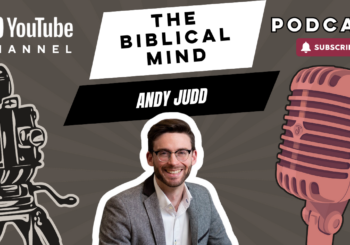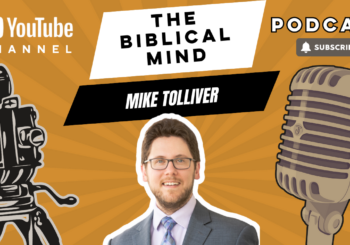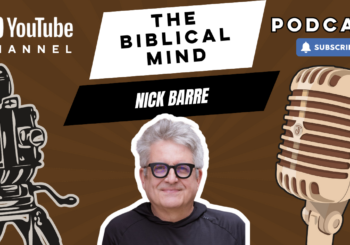Part of the Family Conflicts and the Restoration of the Cosmos series
Family Conflicts and the Restoration of the Cosmos, Part III: The Lion of Judah, or the Kid of Tamar?
Violence filled the earth and God pushed the restart button. God’s strategy to restore this conflicted cosmos rests on one family. The problem is that this family is quite conflicted itself. But that’s exactly the point. Conflict resolution within the elected family becomes the means for the restoration of the cosmos. We’ve learned with Abraham, Sarah, and Hagar in Genesis 16 that this restoration depends on an attitude of humility and servanthood, even to the point of risking one’s life. Hagar, an Egyptian slave, modeled these high standards for Abraham’s family to follow. And it is in the context of Egypt that Abraham’s family must learn to resolve conflicts that have cosmic implications.
Enjoying this article? Read more from The Biblical Mind.
Joseph and his brothers struggle for rulership. Who among them will be one of the kings coming from Sarah, as promised by God in Genesis 17:16? After a dramatic and life-threatening sequence of events, we learn, once again, that humility and servanthood is the way forward to resolve family conflicts and restore the cosmos.
In Genesis 37–50, we learned that the kings coming from Sarah will serve and preserve the lives of those they rule, especially the most vulnerable. Although it seems like the focus of Genesis 37–50 was on Joseph, we will see in this final part of the series that the narrative actually puts Judah in the spotlight. And we will see that the image of humility and servanthood is not the lion of Judah, but a foreign widow.
What Is Genesis 38 Doing Here?
Joseph is sold as a slave to Potiphar in Egypt. That’s a great narrative hook; we want to know what will happen next. But instead of telling us, the next chapter in Genesis shifts to a story about Judah and his family. The intrusion of this story has puzzled interpreters for a long time. Thanks to scholars more trained in literary criticism,1Robert Alter must be recognized here as a pioneer who paved the way for a better appreciation of the literary artistry of biblical narratives in its final form, including the role of Genesis 38 in its literary context of Genesis 37–50. See Robert Alter, The Art of Biblical Narrative, Revised and Updated (New York: Basic Books, 2011), 1–13. we now have good reasons to see Genesis 38 as crucial to understanding the whole meaning of Genesis 37–50.
By paying attention to the literary markers that connect Genesis 38 with Genesis 37–50, David A. Bosworth qualifies it as a mise-en-abyme.2The Story within a Story in Biblical Narrative (Washington, DC: The Catholic Biblical Association of America, 2008). In a mise-en-abyme, the small unit and the whole create a dynamic in which both parts are interpreted in light of the other. Let’s consider the literary connections.
Judah was the brother who proposed to sell Joseph as a slave (Gen 37:26–27), which leads Joseph to be “brought down” (hûrad, Gen 39:1) away from his family. After this event, Judah himself decides to “go down” (wayyēred, Gen 38:1) from his family. So, the continuation of Joseph’s story in Genesis 39:1 uses the same verb as the beginning of Judah’s story in Gen 38:1.
Deception is an important motif in the whole narrative of Genesis 37–50. Interestingly, a goat is used in Genesis 37 and 38 as part of the deception scheme of the brothers against Joseph and of Tamar against Judah. The brothers dip Joseph’s clothes in the blood of a he-goat (śǝʿîr ʿizzîm, Gen 37:31) to deceive their father. And a goat kid (gǝdî-ʿizzîm, Gen 38:17) becomes the proof that Judah was deceived by Tamar.
We have, then, a marker that connects Genesis 38 with its literary context on the level of plot and motif. The other marker is more significant. Threatened to be burned to death, Tamar sends (šālǝḥâ, Gen 38:25) Judah’s distinctive personal belongings, and commands him to “recognize!” (hakker-nāʾ, Gen 38:25). This is a clear reference to the episode when Joseph’s brothers send (wayĕšallĕḥû, Gen 37:32) his distinctive garment dipped in the blood of a he-goat for Jacob to “recognize!” (hakker-nāʾ, Gen 37:32). This one textual marker relates Judah’s role in the crime committed against Joseph and against Tamar. In the case of Genesis 38 it is the starting point of his character transformation. Such transformation is indicated by his dramatic outcry: “She is the righteous one, not I” (Gen 38:26).3According to Bruce Waltke and M. O’Connor, An Introduction to Hebrew Biblical Syntax (Winona Lake: Eisenbrauns, 1990), 265–6, the Hebrew syntactical construction with mimmennî is “a comparison of exclusion,” meaning that only one part of the comparison possesses the quality of the adjective or stative verb, to the exclusion of the other part compared. For this exact translation, see Richard J. Clifford, “Genesis 38: Its Contribution to the Jacob story.” Catholic Biblical Quarterly 66 (2004): 530.
Judah’s recognition of Tamar’s righteousness is crucial for understanding the whole meaning of Genesis 37–50. We have seen, in my previous article, that Genesis 37–50 is about the character of the kings who will come from Sarah. Instead of ruling over their subjects, as they appear to do in Joseph’s dreams, they must risk their own lives for the benefit of their subjects. This profound lesson is condensed in the short story of Judah and Tamar, which becomes the starting point for the moral development in the rest of Genesis 37–50.
In Genesis 38, Judah is living in a foreign country, marries a Canaanite woman, and has three children with her. His oldest son, Er, also marries a Canaanite woman, Tamar.4Tamar’s identity is never mentioned as it was with Judah’s wife. But her Canaanite origin is derived from the whole context in the land of Canaan. See Clifford, “Genesis 38,” 525–6. Although the name Tamar is derived from the extraordinary fruitful date palm tree, she bears no children. God considers Er wicked, so he makes him die before he can have children. Judah tells his brother, Onan, to have sex with Tamar to give Er an heir. He takes the opportunity to have sex with Tamar, but he intentionally acts not to give his oldest brother an heir. (Brothers disputing their position within the family sounds like Joseph and his brothers.) God considers this act evil and makes him die as well. Is this Tamar’s fault? Will Judah’s lineage disappear because of a Canaanite?
What is at stake here is Judah’s lineage and God’s promise and plan for the elected family. Therefore, this is a threat to God’s plan of restoration for the whole cosmos. Just as Jacob’s favoritism toward his youngest son Joseph endangered his whole family, now Judah endangers his lineage by returning Tamar to her father’s house as a widow to protect his youngest son, Shelah.
In such circumstances, what is Tamar to do? Most importantly, her action is based on her commitment to Judah’s family, those who have wronged her so badly. What Tamar does is front and center in the lesson we can learn from her story.
There is no hint that Tamar dresses or intends to be seen as a “prostitute” (zōnâ). It is Judah who sees her in this way
Deprived of any authority to demand her rights within Judah’s family, Tamar makes a risky move. She removes her widow garments, dons a veil, and waits where Judah will pass by on his way to the sheep shearing (Gen 38:12–14). There is no hint that Tamar dresses or intends to be seen as a “prostitute” (zōnâ). It is Judah who sees her in this way (Gen 38:15). Judah’s perception might have been influenced by the fact that sheep shearing was an occasion of both work and joyful festivities, including heavy wine consumption and promiscuous sex. It is he who advances toward her and proposes sex. She agrees.
Tamar is risking her life for the well-being of Judah’s family, even though they wronged her again and again. That’s the definition of Tamar’s righteousness.
Tamar has resolved to give her husband an heir. If she cannot do that by means of Shelah, she will do it by means of Judah. Her priority is to perpetuate Judah’s lineage. And her plan, if successful, would also benefit her. She might regain her rightful place in Judah’s family. However, the riskiness of her plan outweighs any benefits she might derive. To get pregnant in her condition, in her father’s house and still under the authority of Judah, is to put her own life on the line.
Tamar is risking her life for the well-being of Judah’s family, even though they wronged her again and again. That’s the definition of Tamar’s righteousness. This is quite similar to what we learned from Joseph and his brothers, especially because in both cases those most benefited are the “little ones.” This is explicit in the case of Joseph and his brothers (Gen 43:8; 45:19; 46:5; 47:12; 47:24; 50:8, 21), while in the case of Tamar it is more implicit, with the birth of the twins, just as Joseph had twins. But the concern for the “little ones” becomes a motif in both cases, because the lineage priority of Tamar’s twins and Joseph’s twins is reversed, with the youngest ones surpassing the older ones (Gen 38:28–30; 48:13–20).
My argument for the role of Tamar’s righteousness as a model for the elected family in the whole of Genesis 37–50 goes further, as we will see in the next two topics. However, the final piece of evidence in Genesis 38 for what I will argue next concerns the personal objects Judah gives Tamar as a pledge (Gen 38:17). Judah gives Tamar, by her request, important personal objects that relate to his identity: his cord with his seal, and his staff (Gen 38:18). The cord is probably a type of necklace on which the seal with the owner’s insignia would hang close to its owner’s chest. The staff, appropriate for the purpose of Judah’s travel, sheep shearing, would probably be inscribed with his name on it.5Cf. Othmar Keel, “Ancient Seals and the Bible.” Journal of the American Oriental Society 106.2 (1986): 307–8.
The significance of this is that Judah is relinquishing to Tamar his legal and social standing. This is already quite relevant, but it gets even more interesting if we consider that Genesis 37 is about the struggle of kingship and servanthood between Jacob’s sons from the perspective of Joseph’s dreams and God’s promise concerning Sarah. While the narrative leaves us hanging on the question of how this conflict will resolve, which brother will fulfill this promise, and the character of these kings, we see Judah handing over to Tamar his social standing among the elected family. He gives her objects that represent his tribal authority and, as the narrative develops, even his royal authority. It is this scene that makes Tamar the representative character of what will be developed later in the narrative.
Judah as Protagonist
For several chapters, we return to the story of Joseph to learn his destiny in Egypt before we can meet Judah and his brothers again. Once we do, by chapter 42, a careful reading reveals that Judah is a protagonist among his brother and his family. In all the dealings between Jacob and his sons, as well as the brothers with the not-yet-revealed Joseph in Egypt, it is Judah who is able to resolve the tension and lead the family toward reconciliation.
It all starts with Judah’s arguments with Jacob over the necessity of taking Benjamin to Egypt: “Send the lad with me, and we will arise and go, that we might live and not die, also we, also you, also our little ones” (Gen 43:8). Jacob, like Judah in Genesis 38, wants to protect his youngest son. Judah, however, has learned his lesson from Tamar’s righteousness. Instead of fighting for this favoritism, like he and his brothers did in Genesis 37, he must consider the survival and well-being of the family over his own safety. The lives of the “little ones” are worth the risk.
Then, when the disguised Joseph threatens to imprison Benjamin, Judah argues with Joseph in a long speech (Gen 44:18–34). Near the end of the speech, Judah claims responsibility for the life of Benjamin, expresses his concern for his father, and laments his guilt if he fails to return his little brother to his father (Gen 44:32, 34). And then, he finally shows how far he is willing to take responsibility: he offers his own life in place of Benjamin’s. He would become a slave to free Benjamin (Gen 44:33).
Judah’s willingness to risk his life in favor of his family, instead of struggling for self-preservation, shakes Joseph out of his self-centered petty scheme against his brothers so he can recognize God’s righteousness in all of this.
This is the righteousness Judah learned from Tamar. He offers his own life in favor of his family, in favor of his little brother so that the “little ones” can live. And that’s the turning point for the whole family, especially Joseph. From this point on Joseph recognizes God’s purpose in his tragic experience caused by his brothers’ violence against him (Gen 45:7–8). Tamar’s willingness to risk her life made Judah realize that his self-preservation at Tamar’s expense was unrighteous. Now, Judah’s willingness to risk his life in favor of his family, instead of struggling for self-preservation, shakes Joseph out of his self-centered petty scheme against his brothers so he can recognize God’s righteousness in all of this.
The family conflict was initiated by the brother’s struggle with rulership and servanthood, with dreams of royalty that put the survival of the whole family at risk. The family restoration, survival and well-being are achieved by rejecting this struggle, this kind of destructive royalty. It is by means of self-surrender for the benefit of the others, especially the “little ones,” that the elected family will flourish.
Tamar, a Canaanite, is explicitly designated the righteous one, who becomes the model of righteousness for the elected family in the midst of a struggle for rulership and servanthood, in the context of the divine promise of kings coming from Sarah. The elected family doesn’t merely adopt Tamar’s righteousness; it becomes Judah’s most important character development in Genesis 37–50. His righteousness derives from Tamar’s, his lineage is Tamar’s.
The Blessing of a Violent Lion of Judah?
There is no doubt that Judah is the main focus of Jacob’s testament in Genesis 49. This text is one of the oldest Hebrew pieces of literature in the whole Bible, and is based in even older traditions.6Together with Exodus 15, Deuteronomy 33, and Judges 5, Genesis 49 may historically contain, from the final period of the book of Judges (11th century BCE), separate sayings that might even go back to the 14th century BCE (Raymond de Hoop, Genesis 49 in its Literary and Historical Context [Leiden: Brill, 1999], 55). The classic study of these texts and their dating, although not really on Judges 5, is Frank Moore Cross’s and David Noel Freedman’s Studies in Ancient Yahwistic Poetry (Missoula: Scholars Press, 1950). There is some debate about the date of these texts in their final form today. Kenton Sparks, for example, would date Judges 5 in its final form to the 9th century BCE, and would date Deuteronomy 33 and Genesis 49 to the 7th century BCE. See “Genesis 49 and the Tribal List Tradition in Ancient Israel.” Zeitschrift für die alttestamentliche Wissenschaft 115 (2003): 344. My main purpose here is to understand Genesis 49, especially the emphasis on Judah, in light of my previous literary and theological analysis of the narrative that precedes it. I hope to prove this is a fruitful approach, especially because Genesis 49 is rarely interpreted in its literary context and because the emphasis on Judah is never considered in light of his relationship with Tamar.
We can see that Genesis 49 relates to the narrative of Genesis 37–50 by the motif of violent power as characteristic of the struggle between the brothers. When we turn to the details of the sayings concerning Judah, we have a clear picture of a royal figure with universal power who is above his brothers. Judah’s royal identity is spelled out in verse 10: “The scepter shall not depart from Judah; nor the ruler’s staff ever from between his feet; for certain, let tribute come to him; and may the obedience of the peoples be to him.”7For Genesis 49, all translations are from de Hoop, Genesis 49 in its Literary and Historical Context, 114. Tributes are being paid to him, which might explain the abundance imagery in verses 11–12, and the peoples (ʿammîm) obey him. We are finally meeting one of the “kings of peoples” (malkê ʿammîm) coming from Sarah (Gen 17:16).
The problem, however, is that the saying concerning Judah is probably the one most characterized by violent power and even oppression of his subjects. The first thing said about Judah is where he stands in relation to his brothers: “Your brothers shall praise you; your hand shall be on your enemies’ neck; your father’s sons shall bow down to you” (Gen 49:8). The most significant part of this introduction is the expression “your father’s sons shall bow down to you.” Joseph’s dreams and his family’s reaction to them are marked by the use of the verb “bow down” (hištaḥăwâ, Gen 37:7, 9, 10). And here, in Genesis 49, we see in a much more definitive saying that the brothers will bow down to Judah, not Joseph.
Next, Judah is characterized as a lion who preys (Gen 49:9). This is, of course, a royal image throughout the ancient Near East, especially because of its predatory aggressiveness. In verses 11–12 we move from violence to abundance in the images of vine, wine, and milk.
What do we do with this violent description of Judah’s royal identity, which goes against the moral character development we have seen? The answer I see lies in one object described in two words in Genesis 49:10: the scepter (šēbeṭ) and the ruler’s staff (mǝḥōqēq).
In Genesis 38, the encounter of Judah and Tamar happens in the context of the festival of sheep shearing, and one of the personal objects Judah hands to Tamar is his “staff” (maṭṭê). Although the word used in Genesis 38 is different than the other two used in Genesis 49, we are still dealing with the same object, with each word giving it a nuanced meaning. Previously we saw Judah handing to Tamar his legal and social standing among the elected family. When Judah’s royal identity is finally revealed here in Genesis 49, we cannot forget about Tamar, and her righteous example. We cannot forget that Judah’s royal identity, his “scepter” and “ruler’s staff,” could only be truly his, after his “staff” was handed over to Tamar.
Just as Judah’s character development in Genesis 37–50 depends on Tamar’s righteousness, so also does his royal identity and exercise of power. The whole point of Genesis 37–50 is to invert the logic of the brother’s struggle for rulership and servanthood. If Judah and his lineage are the ones to fulfill God’s promise to Sarah, we have to interpret Genesis 49 and Judah’s royal identity in light of his relationship to Tamar. What makes the royal character of Judah in Genesis 37–50 is not his lion-like violence, nor the abundance of his kingdom, nor the tributes and obedience of peoples, but his self-giving act of righteousness in favor of his brother and his whole family, imitating Tamar’s righteousness.
Inverting the Lion of Judah
Over the course of this three-part series, we’ve learned several important lessons. As the title of the series suggests, God’s plan to restore the cosmos is inextricably linked to the means of reconciliation within the microcosm of the elected family. Throughout the patriarchal narratives, which feature the family context, family conflicts are resolved by morally ambiguous actions. Even in this ambiguity, reconciliation depends on acts of righteousness. What we can conclude from these actions is that righteousness involves risking one’s life for others, especially the most vulnerable, the “little ones.” Such righteousness depends on forgoing the struggle for status within the family or, more specifically, forgoing the struggle for rulership and accepting servanthood.
It is exactly in this context that we are able to notice how the reconciliation within the elected family is related to the restoration of the cosmos in the divine plan. The narrative presents details from Genesis 12–50 in which the cosmic relevance of this family is defined by its royal future and how their royal character will be used and played out in the world’s political arena.
The most striking message of this series is how God’s plan works by inverting expectations and values. The inversion of coercive power to self-giving power is a clear motif in the patriarchal narratives. This was most clearly seen in the Joseph story.
However, I must emphasize one final inversion. We expect the elected family, even the patriarch Abraham and his sons, to be the model of righteousness and reconciliation. The narrative, however, only moves toward restoration because of two foreign women: Hagar, the Egyptian, and Tamar, the Canaanite. This is quite significant, especially in the case of Tamar and her role as a foundation for the royal character of the kings coming from the elected family. Tamar, the woman, outsider, vulnerable, morally ambiguous, violated, and oppressed, displays the ethical model for the kings descending from Judah. This model is not the violent lion of Genesis 49, but the self-giving widow of Genesis 38 who holds Judah’s scepter. For those who are Christians, like me, I would suggest we call Jesus, the king, not the lion of Judah, but the kid of Tamar.
End Notes
1. Robert Alter must be recognized here as a pioneer who paved the way for a better appreciation of the literary artistry of biblical narratives in its final form, including the role of Genesis 38 in its literary context of Genesis 37–50. See Robert Alter, The Art of Biblical Narrative, Revised and Updated (New York: Basic Books, 2011), 1–13.
2. The Story within a Story in Biblical Narrative (Washington, DC: The Catholic Biblical Association of America, 2008).
3. According to Bruce Waltke and M. O’Connor, An Introduction to Hebrew Biblical Syntax (Winona Lake: Eisenbrauns, 1990), 265–6, the Hebrew syntactical construction with mimmennî is “a comparison of exclusion,” meaning that only one part of the comparison possesses the quality of the adjective or stative verb, to the exclusion of the other part compared. For this exact translation, see Richard J. Clifford, “Genesis 38: Its Contribution to the Jacob story.” Catholic Biblical Quarterly 66 (2004): 530.
4. Tamar’s identity is never mentioned as it was with Judah’s wife. But her Canaanite origin is derived from the whole context in the land of Canaan. See Clifford, “Genesis 38,” 525–6.
5. Cf. Othmar Keel, “Ancient Seals and the Bible.” Journal of the American Oriental Society 106.2 (1986): 307–8.
6. Together with Exodus 15, Deuteronomy 33, and Judges 5, Genesis 49 may historically contain, from the final period of the book of Judges (11th century BCE), separate sayings that might even go back to the 14th century BCE (Raymond de Hoop, Genesis 49 in its Literary and Historical Context [Leiden: Brill, 1999], 55). The classic study of these texts and their dating, although not really on Judges 5, is Frank Moore Cross’s and David Noel Freedman’s Studies in Ancient Yahwistic Poetry (Missoula: Scholars Press, 1950). There is some debate about the date of these texts in their final form today. Kenton Sparks, for example, would date Judges 5 in its final form to the 9th century BCE, and would date Deuteronomy 33 and Genesis 49 to the 7th century BCE. See “Genesis 49 and the Tribal List Tradition in Ancient Israel.” Zeitschrift für die alttestamentliche Wissenschaft 115 (2003): 344.
7. For Genesis 49, all translations are from de Hoop, Genesis 49 in its Literary and Historical Context, 114.
Did you enjoy this article? Check out The Biblical Mind podcast.





